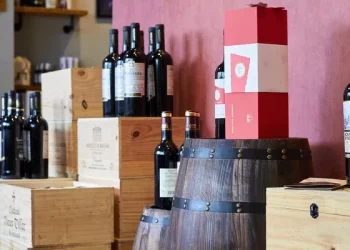Red wine is a popular alcoholic beverage made from dark-colored grapes. It is one of the most widely consumed alcoholic beverages in the world, with a long history dating back to ancient times. Red wine is known for its complex flavors and aromas, as well as its potential health benefits.
The process of making red wine is a complex and time-consuming one, involving several steps that require close attention and care. In this article, we will discuss the basic steps involved in making red wine.
Step 1: Harvesting the Grapes
The first step in making red wine is to harvest the grapes. This typically takes place in the early fall, when the grapes are fully ripe and have reached their peak sugar levels. The grapes are usually picked by hand, although some vineyards use machines for larger harvests. It is important to handle the grapes carefully during the harvesting process to prevent damage to the fruit.
Step 2: Crushing and Destemming
Once the grapes are harvested, they are transported to the winery and sorted to remove any debris or leaves. The next step is to crush the grapes, which breaks the skins and releases the juice. In traditional winemaking, this was done by foot, but now, mechanical crushers are more common.
After crushing, the grapes are destemmed, which involves removing the stems from the grape clusters. Stems are not used in winemaking as they can impart undesirable flavors to the wine.
Step 3: Fermentation
Once the grapes have been crushed and destemmed, the juice is transferred to a fermentation vessel. During fermentation, yeast is added to the juice to convert the sugars in the grapes into alcohol. This process typically takes one to two weeks, and the temperature and humidity are closely monitored to ensure optimal conditions for fermentation.
During fermentation, the skins of the grapes float to the top of the vessel, forming a layer called the “cap.” To extract more color, tannins, and flavor from the grapes, the winemaker must periodically “punch down” the cap by pushing it back down into the juice.
Step 4: Pressing
After fermentation is complete, the wine is transferred to a press, where the remaining juice is extracted from the skins and seeds. The wine is then transferred to barrels or tanks for aging.
Step 5: Aging
Aging is a critical step in red wine production, as it allows the wine to develop more complex flavors and aromas. Most red wines are aged in oak barrels, which can add additional flavors to the wine. The length of the aging process depends on the style of the wine, with some wines being aged for only a few months, while others are aged for several years.
Step 6: Bottling
Once the wine has reached its desired level of maturity, it is bottled. Before bottling, the wine may be fined, a process that involves adding a clarifying agent to remove any remaining sediment. The wine is then bottled, corked, and labeled for sale.
In conclusion, the process of making red wine is a complex and intricate one that involves several steps, each of which is crucial to producing a high-quality product. From harvesting the grapes to bottling the wine, each step requires attention to detail and care. The end result is a complex, flavorful beverage that has been enjoyed for centuries.












































